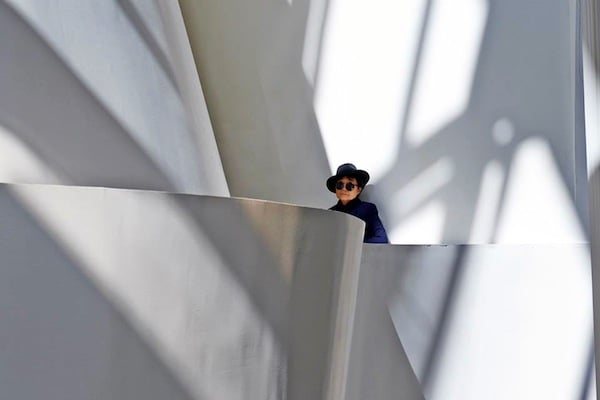Art & Exhibitions
The Essentials: Yoko Ono, Shooting in the Museum, and More
Everything you need to know to start your week.

Everything you need to know to start your week.

Benjamin Sutton

The Interview: On the occasion of her retrospective at the Guggenheim Museum in Bilbao, conceptual art pioneer Yoko Ono chats with the Guardian’s Jonathan Jones, reminiscing about her work in the 1960s that “most people didn’t want to know and I wasn’t about to explain about it. My art was different from what was considered as art. My idea was that maybe one day 50 years later or 100 years later people might discover it.”
The Opinion Piece: The Museum of Modern Art just opened its retrospective devoted to the late conceptual photographer Robert Heinecken. It’s long-overdue exhibition and cruelly ironic, Los Angeles Times art critic Christopher Knight points out. Heinecken not only criticized MoMA’s then-conservative photography during his lifetime but is also conspicuously absent from an exhibition currently on view at the Hammer Museum of UCLA—whose photography program he founded.
The Controversy: Though it opened nearly a year after its original scheduled opening, artist Todd Pavlisko‘s project “Crown” remained a hot topic as it went on public view Saturday at the Cincinnati Art Museum. That’s primarily because the artwork—a minimalist cube that that a Navy SEAL shot with a sniper rifle 19 times, creating 19 indentations or “crowns” in its pristine surface—involved firing a gun inside the beloved institution. “To shoot a gun in the halls in the museum, it’s in bad taste,” said museum shareholder Stewart Maxwell.
The Review: Exploring the Neue Galerie‘s “Degenerate Art: The Attack on Modern Art in Nazi Germany, 1937” in the New York Times, Holland Cotter finds innumerable engrossing, devastating, and contradictory narratives woven into the exhibition and its rich catalogue. He writes: “The show itself is one of the few in an American museum in the past two decades to address, on a large scale, the Nazis’ selective demonizing of art, how that helped foment an atmosphere of permissible hatred and forged a link between aesthetics and human disaster.”
The Double Feature: Artists’ collaborations are tricky. Just ask Sarah Lannan whose work with her better-known half, Simon Evans, tends to be credited to him in spite of her immense contributions to the incredibly detailed and labor-intensive works the couple churns out. “We reached a point in our working relationship where it didn’t feel accurate anymore, the way it was being portrayed,” Lannan told the Wall Street Journal. Other times, collaborations come off with ease, as evidenced by the many works Dieter Roth co-created during his lifetime; currently, his collaborations with Arnulf Rainer are on view at Hauser & Wirth in London.
The List: For no apparent reason, Jonathan Jones picked what he considers to be the “10 weirdest artworks ever.” His selections are enjoyably eclectic, from obligatory Surrealist entries like Salvador Dalí‘s Lobster Telephone (1936) and Giorgio de Chirico‘s The Song of Love (1914), to an enormous 4th-century bust of Emperor Constantine.
The Eye Candy: The group show “Speculations on Anonymous Materials” at Kunsthalle Fridericianum—in which artists including Michele Abeles, Ryan Trecartin, Jon Rafman, Oliver Laric, and others engage with the plethora of images distributed, reinterpreted, traded, and re-contextualized in our contemporary visual culture—is the subject of an exceptionally thorough Contemporary Art Daily slideshow.
The Museum Feature: The Metropolitan Museum launched a new online initiative, MetCollects, wherein newly acquired artworks are extensively examined through photos, articles, documents, videos, and audio commentary. The first batch includes William Kentridge‘s installation The Refusal of Time (2012).
The Gadget: Love Instagram, but miss the in-real-life retro cool of good, old-fashioned slide projectors? Fear not, because now there’s Projecteo, a pocket-sized mini-projector for your Instagram photos.
The WTF: During her set at South By Southwest, Lady Gaga had “vomit painter” extraordinaire Millie Brown join her on stage, gargle green paint, and then throw it up on her while she continued singing.
The Extra-Curricular: Despite calls for restoration from the likes of Norman Foster and Vladimir Putin, Moscow’s iconic Shabolovka radio tower is slated for demolition, and by every indication New York Times architecture critic Michael Kimmelman is in support of the ongoing campaign to rescue it from the wrecking ball. “A model of transparency and structural ingenuity, the tower consists of a series of stacked hyperboloids of diminishing size,” he writes. “Its geometric complexity belies the simplicity of its profile.”